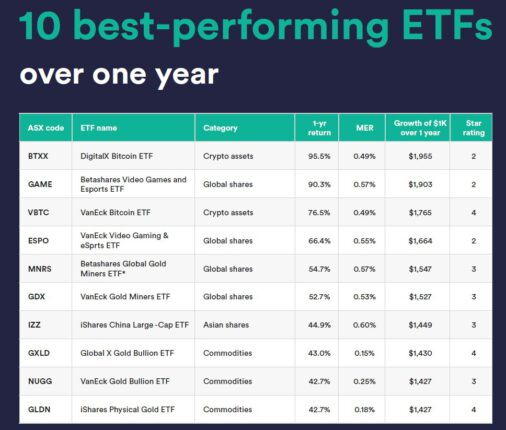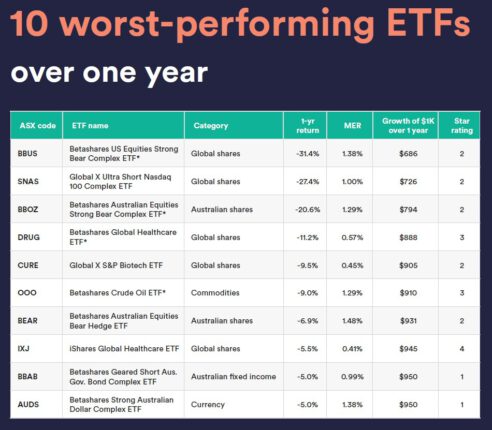Bitcoin, video games and gold ETFs are among the top performing ETFs in 2025, while healthcare, biotech and oil are among the worst
Bitcoin and video games-themed exchange-traded funds (ETFs) were among the best performers among ETFs listed on the Australian Securities Exchange (ASX) last financial year, analysis by InvestSMART has shown.
The DigitalX Bitcoin ETF was the year’s top performer with a return of 95.5 per cent over the year, according to the InvestSMART ETF Scorecard 2025.
In second place, we find the the Betashares Video Games and Esports ETF with a return of 90.3 per cent, while the VanEck Bitcoin ETF returned 76.5 per cent over the year.
The worst performer of the year was the Betashares US Equities Strong Bear Complex ETF, which fell by 31.4 per cent. However, this ETF seemed to perform as it was designed to do as this all futures ETF takes a leveraged bet on the S&P 500 Index losing money.
Since the S&P 500 was up 13.3 per cent for the year, the ETF produced a negative return.
A similar situation can be found with the Global X Ultra Short Nasdaq 100 Complex ETF, the second worst performer at -27.4 per cent. This ETF is designed to make money when US technology stocks lose value. However, the Nasdaq Composite returning more than 15 per cent for the year, driven by stocks such as Tesla (+51 per cent), Meta (+46 per cent) and Nvidia (+27 per cent).

Source: InvestSMART
ETFs Experience Strong Inflows, While Outflows Remain Modest
ETFs are an increasingly popular vehicle to take exposure to a broad basket of stocks, whether they are market-weighted or thematic in nature. Often touted as low cost vehicles, InvestSMART’s analysis shows that not all of them are actually so.
The K2 Australian Small Cap Hedge Fund Complex ETF is the most expensive ETF on the ASX with a fee of 2.56 per cent per annum. But some ETFs only cost a few basis points, with the cheapest ETF, the Vanguard US Total Markets Shares Index ETF, attracting just three basispoints per annum.
Last year, 49 new ETFs were launched and the ASX now count 388 ETFs in total, which have $272 billion in assets under management. Global equities was the most popular ETF category last year and saw $11.5 billion in inflows. Australian property ETFs were least in vogue, although outflows were modest at $42 million for the year.
Among the most popular ETFs were the Vanguard Australian Shares ETF, which returned 14.9 per cent for the year and experienced $3.7 billion in inflows, and the Vanguard MSCI International ETF, which returned 17 per cent and had $2.3 billion in inflows.

Themed and geared ETFs can appeal to sophisticated investors seeking short-term plays, but they carry risks, including amplified losses through leverage. This highlights the importance of taking a good look under the hood of an ETF to understand how it can make (or lose) money
“ETFs have made it easier and more affordable than ever to build a diversified portfolio, so it’s no surprise that Australians are turning to ETFs to build wealth, save for retirement and invest for their children’s future,” Ron Hodge, Chief Executive Officer of InvestSMART Group, said.
Hodge did have a word of warning for investors eyeing thematic ETFs, such as cryptocurrency ETFs, since they can be highly volatile.
“It’s hard to ignore the extraordinary gains in digital currencies – especially Bitcoin – over the past year,” he said. “However, while the returns have been eye-catching, investors need to remember that Bitcoin remains highly volatile. A single-asset ETF that invests in Bitcoin can rise dramatically, but it does leave investors highly exposed to a downturn in the cryptocurrency, which we have seen happen in the past.
“Themed and geared ETFs can appeal to sophisticated investors seeking short-term plays, but they carry risks, including amplified losses through leverage. This highlights the importance of taking a good look under the hood of an ETF to understand how it can make (or lose) money,” he said.
Source: InvestSMART
ETFs with exposure to gold were also heavily represented in the top 10 best performers, including five funds that invest in gold bullion and gold mining companies.
“Investors have traditionally flocked to gold as a safe-haven asset in times of volatility, and this year was no exception,” Hodge said. “Heightened geopolitical tensions and US tariff announcements contributed to a surge in gold prices, and this was reflected in ETFs that invest in gold bullion.”
Chinese large cap shares also did well during 2025 with the iShares China Large-Cap ETF ending the year 44.9 per cent higher.
Another outlier was the Betashares Global Healthcare ETF, which was the fourth worst performer and lost 11.2 per cent over the year. InvestSMART offered that this was due to the global pharmaceuticals industry facing several headwinds, including the Trump administration’s intention to lower drug prices.
Biotech lost money for similar reasons and the Global X S&P Biotech ETF ended the year 9.5 per cent lower.
The Betashares Crude Oil ETF, currency hedged, also suffered, losing 9 per cent for the year.
__________
[i3] Insights is the official educational bulletin of the Investment Innovation Institute [i3]. It covers major trends and innovations in institutional investing, providing independent and thought-provoking content about pension funds, insurance companies and sovereign wealth funds across the globe.



